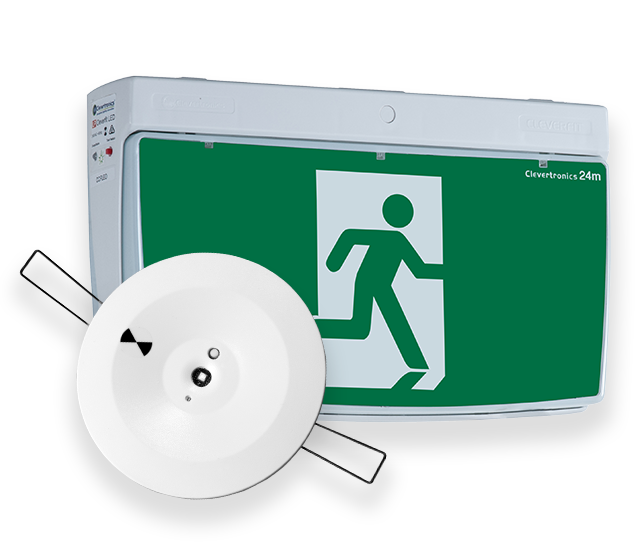WHERE ARE THEY INSTALLED IN A BUILDING?
A licenced electrician with an understanding of the AS2293.1 standard will provide guidance on installation requirements.

Exit signs need to be clearly visible to the occupants of a building and illuminated at all times. They will be installed directly above exit doors, at the top of staircases and at any change of direction along the way to directing people along the “Egress path” escape route to a final exit or evacuation point.
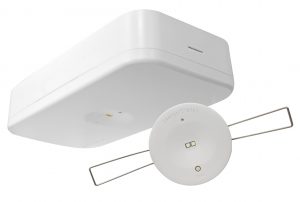


Emergency lights are installed at regular intervals around a building to illuminate the egress paths out of the building. The type of light, building shape and ceiling height will determine where they are required to be installed.
WHAT TYPES OF EXIT AND EMERGENCY LIGHTS ARE THERE?
There are many types of exit signs and emergency lights on the market, each type is targeted to a specific application within a building environment.
Exit Sign Options
Emergency Lighting Options



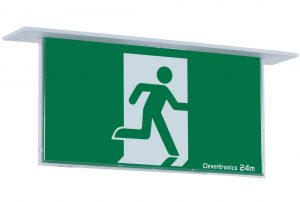

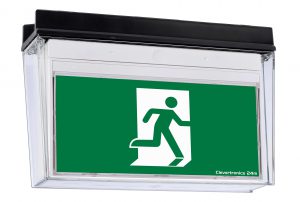

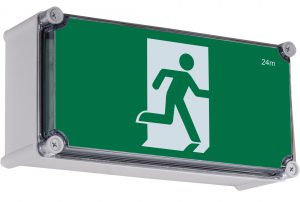

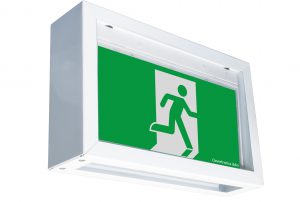

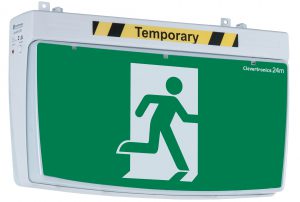

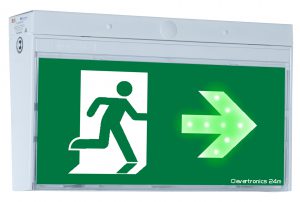




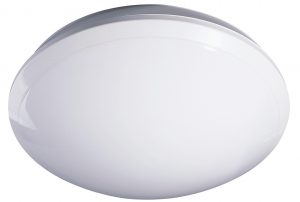

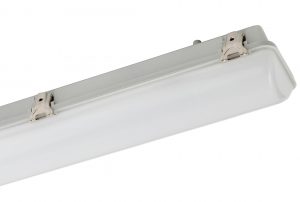

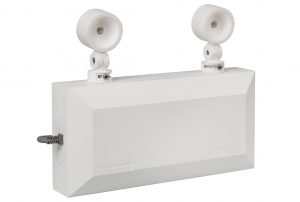

TESTING FITTINGS
There are several ways to test an exit and emergency lighting installation, it all depends on the type of fittings installed and the testing system used in the building design.
All exits and emergency lights must be tested twice yearly to ensure they illuminate via battery backup power for a duration that would allow occupants to exit a building safely in the case of a power outage (a minimum of 90 minutes in AU, 30 or 90 min in NZ depending on the site). The results of the duration test, any defects/non-conformances and maintenance history shall be recorded in a paper or digital log book.
A manually tested system has exit and emergency lights wired to a test timer.* Activation of the test timer should not disrupt the power to the normal lighting. A testing contractor should first walk the site and check that the fittings have power (check the charge light status) and replace any blackened fluorescent tubes. The next step is to activate the test timer to cut the power to the emergency lighting then wait 90 mins (30/90 mins in NZ) and inspect each fitting to see if it is still running.
PROS
- Ability to buy the cheapest fittings available from any brand.
CONS
- Can be very expensive and labour intensive to test – Requires someone to initiate and monitor the test (involves multiple laps of the site)
- Results are often inaccurate –It is rarely possible to inspect every light on a premises at exactly 90 mins (30/90 mins in NZ). The tester must also determine the cause of any failures which often leads to complete fitting replacements instead of cheaper repairs such as replacing a battery.
Self-testing exits and emergency lights
Self-testing Emergency fittings have an in-built timer that automatically puts them into duration test mode every 6 months without the need to physically initiate the test. Following the test each fitting will display a pass/fail result on its LED status indicator. A tester will only need to do one walk around to record a pass or fail from the required test duration. Additional walk arounds may be needed if the site has fluorescent tube emergency fittings that need lamp changes prior to a test.
PROS
- Faster and cheaper to test (by more than 50%), easy to determine the cause of faults leading to cheaper maintenance costs. Easier and more professional *test reporting. Ability to manage multiple locations and remote access of test reports.
CONS
- Physical inspection of each fitting to collect a duration test result. Slightly Increased purchase cost if upgrading to a premium fitting (Approx. 10-15%) over the cheapest available (this is offset though by a longer lasting fitting).
Computer Monitored System
Large sites benefit from having a centrally monitored system to manage the testing and maintenance of the Emergency lighting. This eliminates the need for a person to be present to physically inspect fittings when conducting duration testing on a site.
- A Monitored system is run via a computer (Server) located either on site or by using a virtual cloud-based server.
- The Server conducts automatic testing of the Emergency lights, these can be scheduled remotely.
- The Emergency fittings relay information via a router or controller back to some form of head end Management software. In the market leading monitored system software, live status data on Individual fittings can be viewed for detailed system visibility.
- The Server compiles electronic test reports.
PROS
- No reliance on a person to remember to go to site and initiate a test or collect duration test data.
- Remote access to detailed site information and test reports, and BMS dashboard integration.
- Lower environment impact over system life due to reduced need to travel to site to conduct tests.
- Full control over time and date of testing – test outside of occupied hours, divide areas if needed.
- Flexible secure wireless systems requiring no structured cabling or backbone. (Clevertronics)
- Lifetime support program to keep the system optimised, plus dedicated point of contact and service. (Clevertronics)
CONS
- Some older monitoring systems on the market require additional cabling to each exit and emergency, joined by a communication backbone which adds cost and complexity.
- Monitored systems require commissioning and some systems like DALI rely on expensive third-party integrators to set up or adjust the system. Consider providers who include complimentry lifetime support/training and a system that allows any qualified contractor to access.
- Monitored exit and emergency lights have a higher initial purchase cost compared to a basic manual test fitting.
- Future fittings and additions must be of a brand and model compatible with the installed system to maintain functionality.
FREQUENTLY ASKED QUESTIONS
An appropriately qualified person such as a licensed electrician should be used to test and inspect the components of any style of emergency lighting system. The AS2293 standard includes requirements for testing of circuits and sensing of supply to the test facility which can only be performed by someone with the suitable qualifications.
Costs vary for emergency light duration testing depending on the products and system used.
For a single point/manually tested site (see Manual Duration Testing) a contractor may either charge a call out fee followed by an hourly rate or charge a flat fee determined by the number of fittings on the site. Fees can vary dramatically so it is recommended to choose a reputable contractor that can provide references. Keep in mind that the testing itself is one cost, fitting maintenance or complete product replacements will incur additional costs.
Every exit sign and emergency light will have a visible LED Charge indicator in either a red or green colour.
If the indicator light is on it means that there is power to the fitting and that the battery is being charged. If the charge light is not illuminated it means that either there is no power to the fitting or it has suffered a battery charging failure.
Each fitting will also have a test button next to the indicator, holding this button down will momentarily put the fitting into emergency mode.
Ideally steps should be taken to ensure an emergency lighting system is in perfect health and all fittings are operational at all times.
If you notice any fittings that are not working and pose a risk to occupant safety, you should report them to the maintenance contractor or other responsible party.
That being said the twice-yearly scheduled duration tests will identify faults and list any defects or non-conformances for corrective action. Demonstrating proof that the required repairs identified during the duration test have been carried out is necessary to demonstrate compliance.
Emergency and exit lights products can be purchased from electrical wholesale branches.
Generally, an electrical contractor will quote to supply, install and maintain the log book for your site.
It is important that all parties responsible for the ongoing service, maintenance and compliance of this emergency lighting installation obtain copies of and are familiar with the Australian and New Zealand Standards AS2293 – Exit and emergency lighting for buildings in order to understand the full range of checks and procedures outside duration testing that are required for building compliance.
AS/NZS2293.2 outlines the Routine Service and Maintenance tasks that must be undertaken and recorded on a 6 monthly, 12 monthly and 10 yearly basis in order to ensure that the system operates correctly as per the installed design.
These additional tasks include but are not limited to:
– Cleaning of exit signs and luminaire diffusers to remove dirt and insects
– Visual inspection of fittings for damage or obstructions
– Inspection of the duration test facility for correct operation
– Inspect that replacement fittings installed during maintenance match the classification and spacing requirements of the original design
– Check directional arrows on exit signs are labelled as per the original design
– Review of the maintenance and service records to ensure any defects or non-conformance recorded during the previous tests and inspections have been rectified.
EMERGENCY LIGHTING FOR
BUILDING OWNERS AND TENANTS
Ultimately it is the building owner or tenant that is responsible for ensuring compliance of the emergency and exit lighting within their building.
Emergency and exit lights must be installed, wired and tested by a licensed electrician with an understanding of the AS2293.1 standard and THE APPLICABLE BUILDING OR CONSTRUCTION CODE.
It is important that the company engaged to manage compliance has access to the appropriate baseline data for managing the emergency lighting assets. They must be trained in the use of any automatic or computerised system installed to ensure efficient operation and that any replacement fittings match the system requirements.
All exits and emergency lights must be inspected and tested every 6 months to ensure they run for 90 minutes on battery by simulating a loss of power. The results of the duration test, any defects/non-conformances and maintenance history shall be recorded in a paper or digital log book.
There are three types of testing methods depending on the installation in your building.
- Manual Testing Method – Power is removed from the fittings and a walk through the site is completed at 90 minutes to ensure all lights are still illuminated.
- Self Test Method – Fittings automatically test every six months and results are recorded via LED indicator. A walk through is completed within 7 days to check the LED indicators on each fitting.
- Computerised Automatic System – Fittings automatically test every six months or on demand and a report is produced to show the status of each fitting.
A log book is either a hard copy book or digital version that contains all the information About the emergency and exit lighting in your building.
It contains information about the type of lights, their installed locations including installed date, tested dates, any maintenance carried out and who completed the work. With the CleverSparky App, a free digital logbook that allows you to compile all this information online and store in the cloud, then update records and access information when you need it.
Test Reports and Maintence Records are required to be kept for a period of seven years.
Emergency and exit lighting is an essential life safety device and the non-compliance with regulations regarding its correct installation and maintenance jeopardises the safety of building occupants. There is a legal requirement to comply with NCC and AS2293 and the WH&S legislation (OH&S in Victoria and WA) treats a serious breach as an indictable offence and carries a maximum penalty of $3 million for a corporation and a significant financial penalty and up to 5 years imprisonment for individuals.
Every exit sign and emergency light will have a visible LED Charge indicator in either a red or green colour.
If the indicator light is on it means that there is power to the fitting and that the battery is being charged. If the charge light is not illuminated it means that either there is no power to the fitting or it has suffered a control gear failure. Each fitting will also have a test button next to the indicator, holding this button down will momentarily put the fitting into battery mode.
Ideally steps should be taken to ensure an emergency lighting system is in perfect health an all fittings are in operation at all times.
If you notice any fittings that are not working and pose a risk to occupant safety, you should report them to the maintenance contractor or other responsible party.
That being said the twice-yearly scheduled duration tests will identify faults and list any defects or non-conformances for corrective action. Demonstrating proof that the required repairs identified during the duration test have been carried out is enough to demonstrate compliance.


